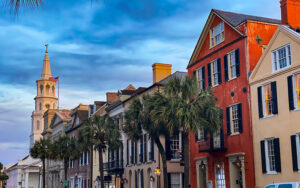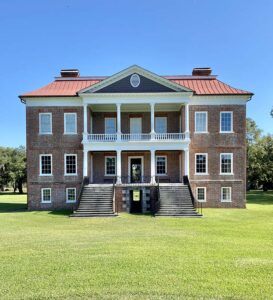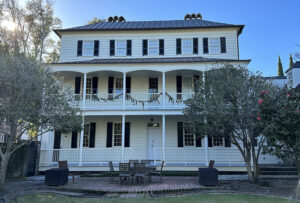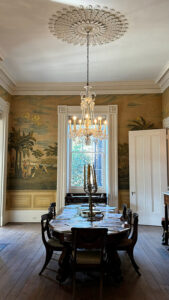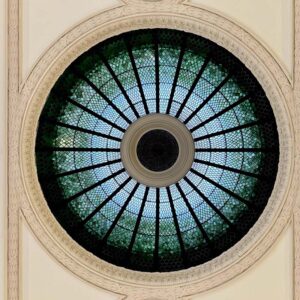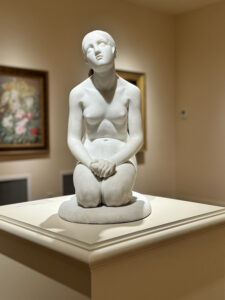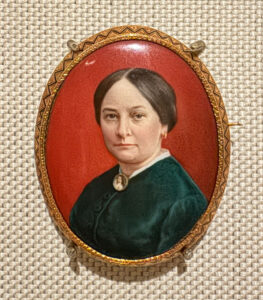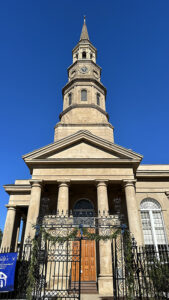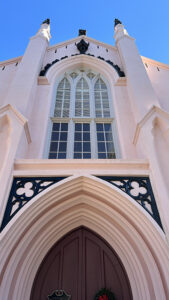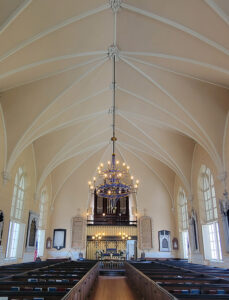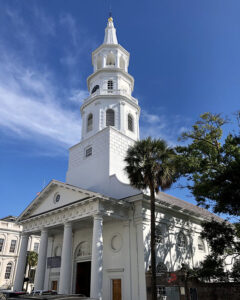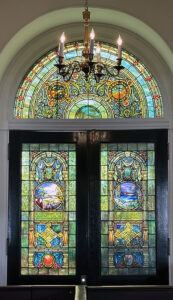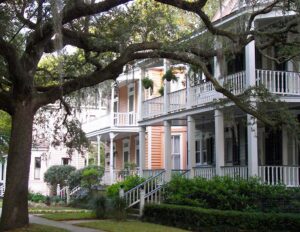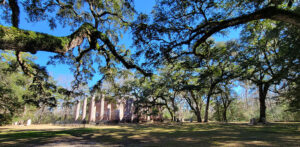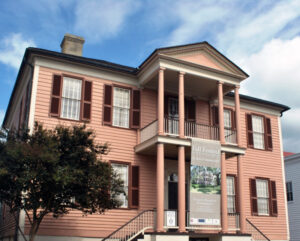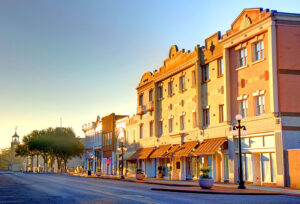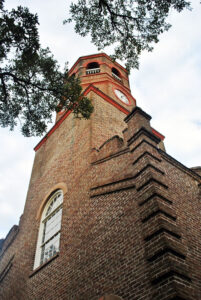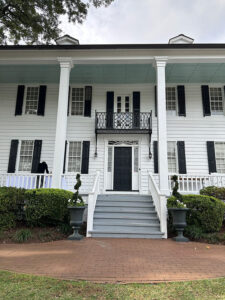Lowcountry Legacies: Charleston and Coastal South Carolina
EVENTS > SYMPOSIA
FALL SYMPOSIUM
November 6–10, 2024
Wrought iron gates and piazza doors swing open when the Trust visits the Holy City of Charleston, where cobblestone streets are lined with pastel-hued houses, live oak trees drip with Spanish moss, and hospitality is considered a competitive sport! As we explore South Carolina’s maritime jewel, a rich heritage of craftsmanship dating back more than three centuries comes into focus. We delight in special access to the city’s beloved and admired residences in the South of Broad, Ansonborough, and Harleston Village neighborhoods. Scholars, preservationists, and curators lead our guests through a proper showcase of the Lowcountry’s history, architecture, interiors, and complex narratives, as well as Charleston’s remarkable legacy of advancing historic preservation. From a spectacular opening salvo at Drayton Hall to the city’s palmetto-lined streets and vibrant architecture, Charleston’s picturesque environs keep us captivated, curious, and charmed.
REGISTRATION NOW CLOSED
Thursday, November 7, 5:00 pm–9:15 pm
Welcoming Remarks and Opening Program at Mills House
The Jonathan L. Fairbanks Lecture
High Times in the Low Country
J. Thomas Savage, Director of Educational Travel and Conferences, Colonial Williamsburg Foundation
Opening Reception at Drayton Hall and featuring a Grand Illumination and reimagining of the house’s 18th-century forecourt, spectacularly designed by Ralph O. Harvard and William Hiley
Sponsored by:![]()
Friday, November 8, 8:45 am–5:00 pm
Townhouses and Tenements: Architecture in Charleston before 1740
Dr. Louis Nelson, Professor of Architectural History and Vice Provost of Academic Outreach, University of Virginia
“Our Temple… our Jerusalem”: A History of the Synagogues of Kahal Kadosh Beth Elohim
Harlan Greene, Director of Archival and Reference Services, College of Charleston
After our morning lectures, we depart on a walking tour within the bounds of the original walled city, focusing on the ecclesiastical structures for which Charleston earned the nickname of the Holy City. Construction on St. Michael’s Church began in 1751, but the interior was not completed until over 150 years later with the addition of a stained glass apse and surrounding design work by Tiffany Studios. Its iconic bright white steeple stretches above the famed intersection of Meeting and Broad Streets, known locally as the Four Corners of Law. The St. Philip’s Church congregation was established in 1680 and is considered the oldest in the state. Construction of the edifice began in 1835, and its stunning and imposing tower, which was once used as a beacon for ships coming into the harbor, was erected c. 1849. The French Huguenot Church was established by French Protestants in the late 17th century and boasts a rich history reflected in its architectural evolution. The original masonry building was destroyed by fire in 1796. The present 1845 structure by Charleston architect Edward Brickell White was the city’s first Gothic Revival ecclesiastical building. A classic Southern lunch revives us as we turn from the religious to the residential. Our afternoon tours take us behind the doors of private houses north of Broad Street. Dating to 1810, the Simon Jude Chancognie House was built by a French merchant and consul on a spacious corner lot in what is today called the Ansonborough neighborhood. Trust member Juliana Falk shares her “accidental” and devoted journey to preserve, research, and restore this endlessly fascinating Federal home. Sprawling over an acre in Harleston Village, one of Charleston’s earliest suburbs, the Gaillard House is a grand 1800 residence built for a successful rice planter. Once we step beyond its gracious double portico entry, we admire one of the city’s best interiors with the finest and most intricate plasterwork in the city complemented by the homeowner’s fine furnishings. The vast walled garden retains three carefully restored Gothic dependencies, and the carriage house is among Charleston’s most distinctive.
Saturday, November 9, 8:45 am–5:00 pm
Standing up for Charleston: Sustaining a Preservation Legacy
Brian Turner, President and CEO, Preservation Society of Charleston
Our morning lecture inspires us to consider the future as we study the past, which will be at the top of our minds during tours featuring privileged access in Charleston’s elegant South of Broad neighborhood. Rainbow Row was developed c. 1740 as mixed-use structures with merchants’ residences above their shops. The area had declined by the Civil War, but, in 1931, Dorothy Porcher Legge and her husband saw promise, sparking the colorful transformation that made Rainbow Row a beloved landmark. We are welcomed inside a particularly intact late 18th-century residence, which retains its original woodwork and transitional Georgian-to-Neoclassical moldings. Located at a gentle bend on brick-paved Church Street, the c. 1743 George Matthews House is an early variation of a Charleston double house. The long-time owner has lovingly furnished the interior and cultivated a lush rear garden. Standing tall on Legare Street is the magnificent Greek Revival William C. Gatewood House. Built in 1843 for a well-to-do Virginian, this sprawling residence was meticulously and warmly restored after periods of neglect and natural disaster. The entrance level is snug and inviting, but the upper parlor floor was built for grand entertaining. The grounds include a potted citrus garden, pool, and restored stables. We are hosted for lunch on the vast triple piazzas of a stunning Antebellum residence on Legare Street that overlooks a Charleston paisley garden. After lunch we are whisked away to the Gibbes Museum of Art for expert-led tours delving into the museum’s exceptional collections of early Charleston portraits, miniatures, furniture, silver, and crafts.
Sunday, November 10, 8:45 am–11:15 am
A Feminine Touch: Women in Charleston’s Silver Industry
Charlotte Crabtree, Proprietor, The Silver Vault of Charleston
John A.H. Sweeney Emerging Scholar Lecture
Unearthing the Old City: Archaeology of the 17th Century at the Heyward-Washington House and Beyond
Sarah Platt, PhD, Assistant Professor of Anthropology, College of Charleston
African Routes: the Lasting Impact of the Diaspora in the Lowcountry
Malika N. Pryor, Chief Learning and Engagement Officer, International African American Museum
The Marie Zimmermann Emerging Scholar Lecture
Beyond the Ashes: The Renewed Vision of the Charleston Renaissance
Chad Stewart, Curator of History, The Charleston Museum
Symposium concludes
SPONSOR RECEPTION
Friday, November 8, 6:30 pm– 8:45 pm
Decorative Arts Trust members at the Sponsor level and above will receive an invitation to this special reception. We are grateful for the hospitality of Mrs. Bessie Hanahan who welcomes us to the superb c. 1759 Charles Elliott House on Legare Street. Having recently restored the classic Charleston single house to its original Georgian grandeur and adorned it with her carefully considered collection of early Southern decorative arts, Mrs. Hanahan is a passionate advocate for preservation and the study of material culture. The Trust is pleased to have this additional opportunity to express our gratitude for the generous support of our members!
FUNDRAISER FOR THE EMERGING SCHOLARS PROGRAM
Saturday, November 9, 6:30 pm– 8:45 pm
We are delighted by the invitation to join Trust members Kelly and Randy Schrimsher at their elegant c. 1810 Church Street residence for our Emerging Scholars Program Fundraiser. The house began as the store and dwelling of a French-born grocer and was subsequently used as a doctor’s receiving room, school, and antique shop. This history serves as a fascinating background for the Schrimshers’ outstanding collection of Classical American furniture. As dedicated supporters of the Trust’s Emerging Scholars Program and through Randy’s past service as Treasurer and President of the Trust’s Board of Governors, their commitment to the future of the decorative arts field is inspiring. Please join us for a wonderful evening of connoisseurship and conviviality as we toast our hosts’ hospitality and lend support to the Trust’s efforts to encourage the next generation of curators and academics through a growing series of grants, scholarships, and internships. In 2024, more than 50 graduate students and young professionals will benefit from the Trust’s Emerging Scholars Program.
A tax-deductible donation of $500 per person and prior registration is required to attend this fundraiser. Attendees will receive a copy of the soon-to-be-published book on the Schrimshers’ collection, and lead authors Peter Kenny and Alexandra Kirtley will be on hand to discuss highlights of their New York and Philadelphia furniture.
PRE-SYMPOSIUM OPTIONAL TOUR
Beaufort: Inner Coastal Enchantment
Wednesday, November 6, 8:30 am to Thursday, November 7, 4:00 pm
Steeped in history, Beaufort is one of the Palmetto State’s oldest cities, second only to Charleston. Our overnight exploration of this charming Lowcountry community begins with the endlessly evocative ruins of Old Sheldon Church to enjoy the peaceful setting where the remains of one of the earliest temple-form churches in the United States still stands. After a relaxing coastal luncheon, we arrive in downtown Beaufort and quickly become acquainted with its enduring appeal. An orientation walking tour familiarizes us with the historic commercial district and earliest residential neighborhoods before checking in to our convenient and comfortable accommodations at the Sea Island Inn. Our exploration of the Bluff Neighborhood includes entry into two exceptional houses. The c. 1805 Robert Means House features original King of Prussia marble mantels and floor-to-ceiling cypress paneling capped by elaborate cornices. Our host’s collection of archaeological artifacts will provide new depth to our understanding of Beaufort’s past. Next door, we are welcomed into the Thomas Fuller House, also known as “Tabby Manse,” built c. 1800. This home is considered to have some of the finest architectural features in Beaufort’s National Historic Landmark District. The home employs a unique Beaufort construction material called tabby, a mixture of oyster shells and lime. The exterior walls are nearly two feet thick and covered with stucco to give the appearance of stone. Our gracious host invites us to enjoy evening refreshments overlooking the Beaufort River before an independent evening downtown.
Thursday opens at Beaufort’s c. 1800 Elizabeth Barnwell Gough House, built for its namesake by her brother. Their father was a notable Beaufort figure, and the home was a grand estate in the community, featuring magnificent cypress paneling and a ballroom on the second floor. Some of the house’s interior architectural elements were sold during the Great Depression, only to come back again by a preservation-minded couple in the 1970s. A visit to the Historic Beaufort Foundation’s c. 1804 John Mark Verdier House permits us to examine quintessential Beaufort architecture and objects in a prominent Neo-classical mansion. After lunch, we continue to the Old Point neighborhood, where some of the largest and grandest homes were built. We are welcomed by the gracious owners of the c. 1780 Elizabeth Hext House, one of Beaufort’s oldest homes, which was built overlooking the Beaufort River during a building boom that resulted from the economic success of growing and exporting indigo. Steps away is the 1853 Edgar Fripp House. Also known as “Tidalholm,” Fripp built it as a summer residence along the Beaufort River to use as a retreat from his St. Helena Island plantation. The original Italianate Villa-style house took on a more traditional appearance after it suffered severe hurricane damage in 1893. The house served as the backdrop for the films The Great Santini and The Big Chill and is enjoying a new era of stewardship.
POST-SYMPOSIUM OPTIONAL TOUR
Georgetown: Harborfront History
Sunday, November 10, 11:30 am–7:30 pm
Travel north with us across the Santee River to Georgetown, the third oldest community in the state, founded in 1729. Georgetown thrived as a center of rice and indigo plantations during the 18th and 19th centuries, making it the wealthiest county in the country. The town retains an astonishing quantity of 18th-century structures. The c. 1769 Kaminski House exemplifies the Georgetown interpretation of Charleston’s single house plan: a long, narrow dwelling built for the hot climate that originated in Barbados. The residence features a raised foundation, hipped roof, and central hall dividing the first floor into two rooms. Originally boasting piazzas on both floors, the house’s narrow design facilitated air circulation, and the porch was oriented for optimal summer breezes coming off the river, which sits just steps from the front door. We are invited to the private Jane Scott House built in 1780 to admire the architectural woodwork. Construction on the Prince George Winyah Parish Church began in 1740 and the first service was held in 1747. The church was not fully completed, however, until 1755, with a steeple added in 1824. The interior features historic box pews and a unique stained glass window, brought from a chapel constructed for the enslaved workers of a nearby plantation. We also experience Georgetown by foot with a local expert who focuses on the town’s 300-year-old commercial history with particular emphasis on a tavern turned home, the c. 1734 Thomas Bolem House. The 1824 Georgetown County Courthouse was executed by Charleston-born architect Robert Mills, designer of the Washington Monuments in Baltimore and Washington. We conclude the day’s activities with a reception to toast our spectacular journey exploring the bountiful Low Country.
ACCOMMODATIONS
Mills House Hotel, 115 Meeting Street, Charleston, SC
Special Room Rates: A block of rooms is reserved for November 5–11, 2024, at variable rates dependent on the day of the week ranging from $299–$499 per night. These rooms are available on a first-come first-served basis until October 15. Please make your reservations as soon as possible by calling 888.908.2097 or booking online via the Mills House Hilton website. If you are attending the Pre-Symposium or Post-Symposium Optional Tours, please reserve a room for the duration of your stay in Charleston. Please note that the Pre-Symposium Tour includes an overnight stay in Beaufort at the Sea Island Inn, which is included with registration.
TERMS AND CONDITIONS
Registration fee: $1,250 per person, which includes all lectures, tours, meals, receptions, and transportation referenced as well as a $50 tax-deductible donation to the Dewey Lee Curtis Scholarship Fund to underwrite symposium scholarships (see below). Participants may elect to make an additional donation through registration.
Student and Young Professional fee: $600 per person, limited to current graduate students and nonprofit professionals less than 5 years from the completion of a degree. The Trust also awards at least two Dewey Lee Curtis Symposium Scholarships for graduate students or young professionals. Applications are due by September 6, 2024.
Optional programs: The Pre-Symposium Optional Tour is $650 for a single registration and $1,100 for two participants sharing a room, and includes hotel accommodations at the Sea Island Inn in Beaufort for the night. For this Pre-Tour, a couple or two people sharing a hotel room should only select the “two people, double room” option once during registration. The Post-Symposium Optional Tour is $375 per person. The Saturday evening fundraiser for the Trust’s Emerging Scholars Program is $500 per person, fully tax deductible. All fees include transportation, admission, and food and beverage as referenced in the brochure. Registration for optional programs is limited.
Membership: All participants must be members of the Decorative Arts Trust. Visit decorativeartstrust.org/join for membership levels and benefits. Members at the Sponsor level and above are invited to a special event on the evening of Friday, November 8.
Cancellations and Refunds: All cancellations received by August 31, 2024, are subject to a full refund less a $100 administrative fee per person. Participants canceling between September 1 and October 1, 2024, will receive a 50% refund. Refunds will not be made after October 1, 2024.
Itinerary: The schedule, sites, and events outlined in this itinerary are subject to change as necessary.
Participation: The program is limited to a maximum of 75 members. We will organize and maintain waitlists. The Trust’s Symposium itineraries are planned with care and attention to detail to ensure a memorable and rewarding experience for all participants. This itinerary includes standing for long periods of time, walking on uneven surfaces, and ascending and descending stairs without handrails. Please consider if this program is suited for your health, physical condition, and individual circumstances.

